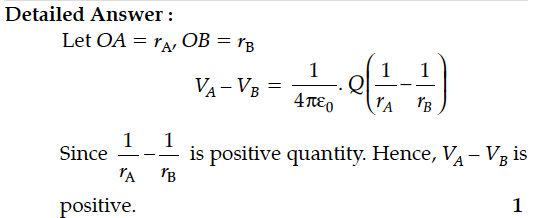A point charge +Q is placed at point O as shown in the figure. Is the potential difference – positive, negative or zero ?


Positive.


A point charge Q is placed at point ‘O’ as shown in figure. Is the potential at point A, i.e., , greater, smaller or equal to potential, at point B, when Q is (i) positive, and (ii) negative charge?
For any charge configuration, equipotential surface through a point is normal to the electric field. Justify.
Why are electric field lines perpendicular at a point on an equipotential surface of a conductor ?
An electron is accelerated through a potential difference V. Write the expression for its final speed, if it was initially at rest.
Two point charges q and –2q are kept d distance apart. Find the location of the point relative to charge q at which potential due to this system of charges is zero.
Give an example of a material each for which temperature coefficient of resistivity is:
(i) positive, (ii) negative.
Two equal balls having equal positive charge ‘q’ coulombs are suspended by two insulating strings of equal length. What would be the effect on the force when a plastic sheet is inserted between the two ?
The plot of the variation of potential difference across a combination of three identical cells in series, versus current is shown below. What is the emf and internal resistance of each cell ?
State which of the two a capacitor or an inductor, tends to become SHORT when the frequency of the applied alternating voltage has a high value.
Two identical cells, each of emf E, having negligible internal resistance, are connected in parallel with each other across an external resistance R. What is the current through this resistance ?
A point charge +Q is placed at point O as shown in the figure. Is the potential difference – positive, negative or zero ?
Why must electrostatic field at the surface of a charged conductor be normal to the surface at every point ? Give reason.
